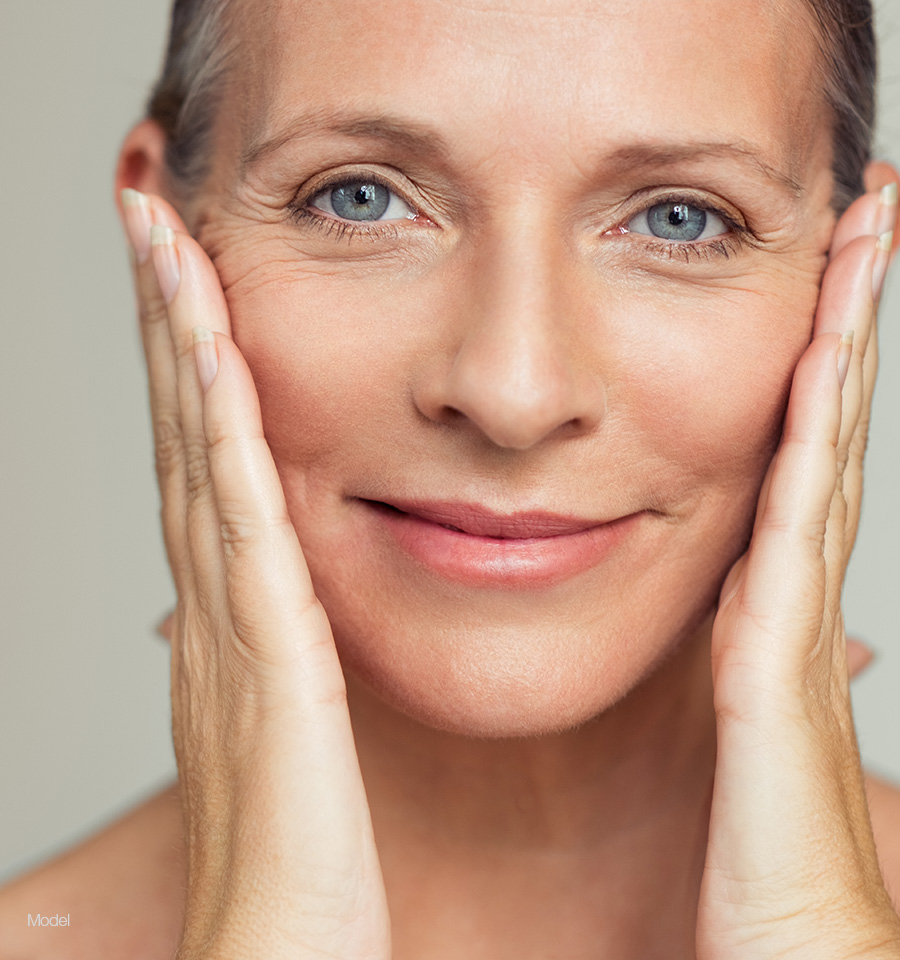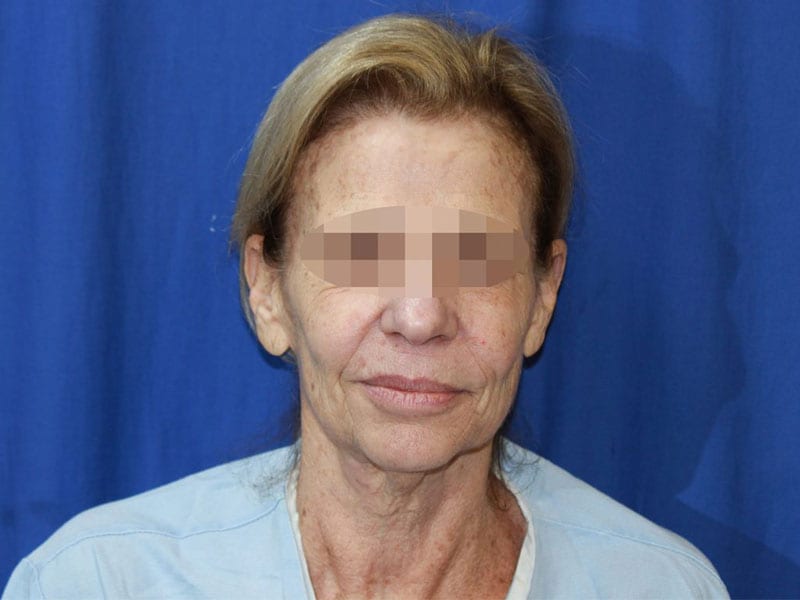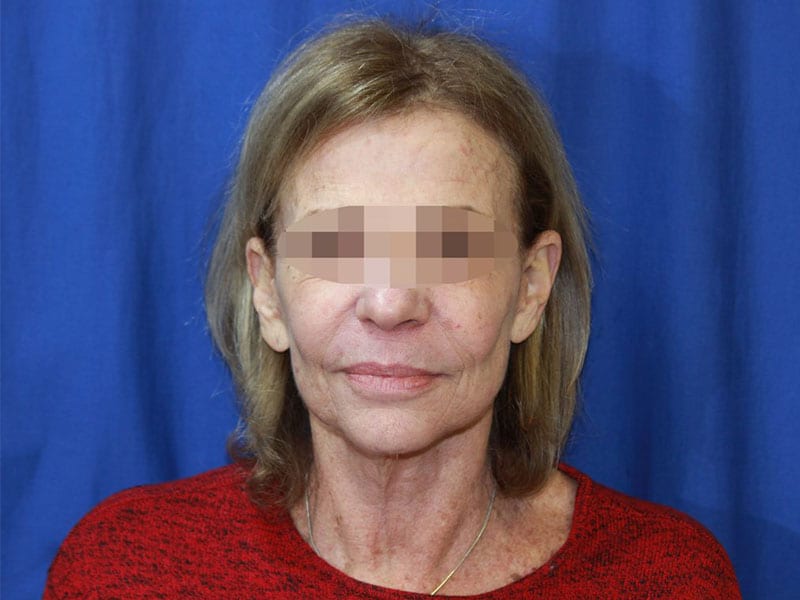
What is Facelift Surgery?
At our offices in Westchester and New York City, facelifts are one of the most popular procedures Dr. Rothaus performs. His facelift surgical procedure uses the latest rejuvenation techniques to tighten underlying facial tissues, remove loose skin on the face and neck, and eliminate excess fat. This improves the appearance of the cheeks, wrinkles, loose jowls, an undefined jawline, and sagging skin around the neck. Dr. Rothaus is one of only a few plastic surgeons to utilize the Harmonic scalpel during this surgery. With the Harmonic facelift, there is very little bruising and swelling compared to conventional facial surgeries. Combined with nonsurgical skin rejuvenation treatments such as Botox® and fillers or a skin resurfacing procedure, the results of this procedure can take a decade off one’s appearance.
What is a Mini Facelift?
A mini facelift is designed to minimize wrinkles and sagging in the cheek and jawline areas. Less invasive than a traditional facelift and often referred to as a “weekend facelift,” the mini facelift is popular among individuals looking to enhance their facial appearance and undergo a shorter recovery time. Dr. Rothaus even offers this procedure under local anesthesia, minimizing the need for sedation and downtime for qualifying patients.
Are You a Good Candidate for Facelift Surgery?
Good candidates for facelift surgery are men or women seeking a more youthful appearance who demonstrate:
- Lax skin in the mid-face, neck, and jawline
- Deep lines and folds around the nose and mouth
- Neck bands
- Submental fat
How Does Facelift Surgery Work?
First, the patient will speak with Dr. Rothaus about their aesthetic needs, goals, and expectations for the facelift procedure. He will walk them through the details of rhytidectomy surgery, including preparation, the procedure itself, and the recovery process, allowing for discussion of any questions or concerns.
The patient and Dr. Rothaus will discuss their complete medical history, including any facial procedures they have had performed previously, any allergies they may have, and any medications or supplements they are currently taking.
After Dr. Rothaus reviews the patient’s past medical and surgical history, an evaluation will be done of the factors that contribute to facial aging – skin quality, skin laxity, wrinkles, and folds. Facial volume and the underlying bone anatomy will also be assessed. Photographs may be taken at this time. A facial rejuvenation treatment plan will be created that will yield the best results.
Patients with less sagging facial skin may be good candidates for a “mini” lift. Other types of facelifts include a plication of the platysma muscle in the neck and the superficial musculoaponeurotic system (SMAS) layer in the cheek, a tightening of the skin, and removal of the excess fat in the neck. There is also a deep-plane facelift, which repositions the fat pads and muscles within the face. Dr. Rothaus performs all facelift varieties using the Harmonic scalpel which is an advanced surgical technique that minimizes downtime, swelling and bruising. It is also common to combine nonsurgical techniques with facelifts to maximize results. This may include dermal fillers or Botox®, as well as laser treatments such as CoolPeel or Fractional Laser Resurfacing for skin resurfacing, uneven texture and hyperpigmentation, which a facelift alone cannot address. Dr. Rothaus’ comprehensive treatment plan is how he achieves excellent facial rejuvenation results.
You’ll be in great care, as Dr. Rothaus is considered by his patients to offer the best facelift New York City and Westchester residents can look forward to.

What is the Recovery like After a Facelift Procedure?
Rhytidectomy surgery at Rothaus Plastic Surgery is generally done under sedation and local anesthesia. General anesthesia is rarely required and local anesthesia alone is used more and more frequently. Due to the use of the Harmonic scalpel, we have not found it generally necessary to employ drains. In addition, for the same reason, swelling and bruising during facelift recovery are usually minimal, with most patients being able to return to work after one week. For the comfort of our patients, staples are not used during surgery, and patients are seen at approximately day four to five and days 10 -12 for suture removal. Most patients can resume modest exercise in two to three weeks. A complete recovery from surgery occurs in about three weeks. Supplemental procedures, such as non-surgical skin rejuvenation, are often performed after the first week.
How Much Does a Facelift Cost in NYC and Westchester?
The overall cost of a facelift in NYC or Westchester is determined by the details of each specific case. The techniques used to perform the surgery, the type of anesthesia chosen, the amount of tissue removed, and the total time required to perform the procedure all play a role in the final price of a facelift.
Learn More Today Getting a Facelift in NYC
The best way to learn more about an NYC facelift is by contacting Rothaus Plastic Surgery and setting up a facelift consultation with Dr. Kenneth Rothaus. Dr. Rothaus is a board-certified plastic surgeon with years of experience and will be happy to answer any questions you may have regarding this facial procedure and our many other treatment options.
Real Patient Testimonials
Two and half weeks ago I had a facelift and Dr. Rothaus did an amazing job! I had very little discomfort and very little bruising. I went to lunch with my sister in law one week after the surgery and she didn’t notice. When I told her she couldn’t believe how great I looked. Dr. Rothaus is an artist and more importantly a wonderful man.

Turn Back the Hands of Time
Facelifts are becoming more and more common, especially with advanced surgical skills and progressive surgical techniques. Experienced surgeons understand the anatomy of the face and produce results that are not only lasting but also natural by appearance. If you are ready to turn back the hands of time and look younger today, we encourage you to contact us and schedule a complete consultation with NYC facelift expert, Dr. Rothaus. We proudly serve patients in New York City, Manhattan, Westchester, and the neighboring communities.
Other Procedures
Frequently Asked Questions
Does a facelift make you look younger?
How do I prepare for a facelift?
How long after a facelift can I exercise?
How long does facelift last?
How long is recovery from a facelift?
How painful is a facelift?
What is best age for facelift?

About Dr. Rothaus
Kenneth O. Rothaus, MD is a board-certified Manhattan and Westchester plastic surgeon offering cosmetic and reconstructive surgery for the face, breast, body, and skin. Educated at Yale College and Harvard Medical School, Dr. Rothaus’ general and plastic surgery training was at the Columbia and Cornell campuses of the New York Presbyterian Hospital. Dr. Rothaus values the wants and needs of his patients and strives to give them the best experience possible.
Learn More

